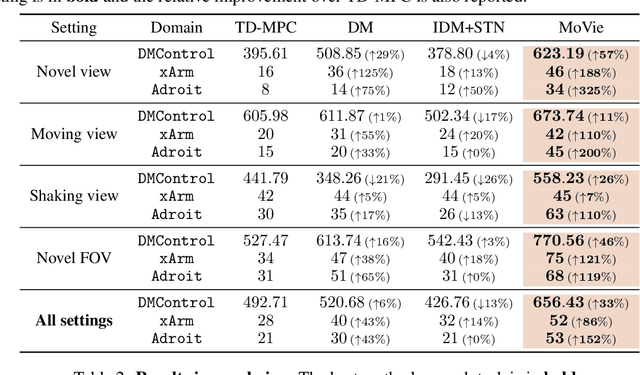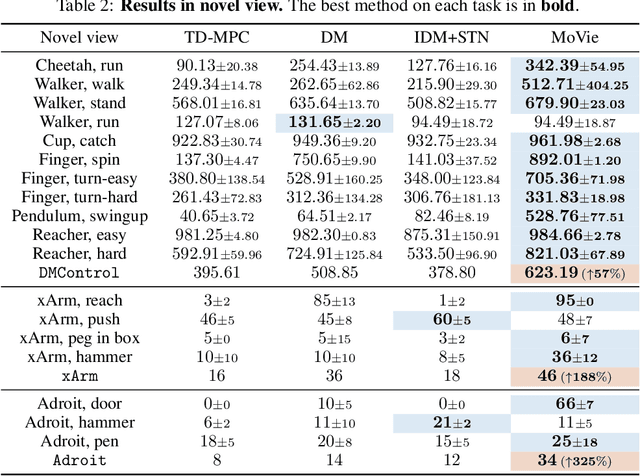Sizhe Yang
MMSI-Bench: A Benchmark for Multi-Image Spatial Intelligence
May 29, 2025Abstract:Spatial intelligence is essential for multimodal large language models (MLLMs) operating in the complex physical world. Existing benchmarks, however, probe only single-image relations and thus fail to assess the multi-image spatial reasoning that real-world deployments demand. We introduce MMSI-Bench, a VQA benchmark dedicated to multi-image spatial intelligence. Six 3D-vision researchers spent more than 300 hours meticulously crafting 1,000 challenging, unambiguous multiple-choice questions from over 120,000 images, each paired with carefully designed distractors and a step-by-step reasoning process. We conduct extensive experiments and thoroughly evaluate 34 open-source and proprietary MLLMs, observing a wide gap: the strongest open-source model attains roughly 30% accuracy and OpenAI's o3 reasoning model reaches 40%, while humans score 97%. These results underscore the challenging nature of MMSI-Bench and the substantial headroom for future research. Leveraging the annotated reasoning processes, we also provide an automated error analysis pipeline that diagnoses four dominant failure modes, including (1) grounding errors, (2) overlap-matching and scene-reconstruction errors, (3) situation-transformation reasoning errors, and (4) spatial-logic errors, offering valuable insights for advancing multi-image spatial intelligence. Project page: https://runsenxu.com/projects/MMSI_Bench .
Novel Demonstration Generation with Gaussian Splatting Enables Robust One-Shot Manipulation
Apr 17, 2025Abstract:Visuomotor policies learned from teleoperated demonstrations face challenges such as lengthy data collection, high costs, and limited data diversity. Existing approaches address these issues by augmenting image observations in RGB space or employing Real-to-Sim-to-Real pipelines based on physical simulators. However, the former is constrained to 2D data augmentation, while the latter suffers from imprecise physical simulation caused by inaccurate geometric reconstruction. This paper introduces RoboSplat, a novel method that generates diverse, visually realistic demonstrations by directly manipulating 3D Gaussians. Specifically, we reconstruct the scene through 3D Gaussian Splatting (3DGS), directly edit the reconstructed scene, and augment data across six types of generalization with five techniques: 3D Gaussian replacement for varying object types, scene appearance, and robot embodiments; equivariant transformations for different object poses; visual attribute editing for various lighting conditions; novel view synthesis for new camera perspectives; and 3D content generation for diverse object types. Comprehensive real-world experiments demonstrate that RoboSplat significantly enhances the generalization of visuomotor policies under diverse disturbances. Notably, while policies trained on hundreds of real-world demonstrations with additional 2D data augmentation achieve an average success rate of 57.2%, RoboSplat attains 87.8% in one-shot settings across six types of generalization in the real world.
Predictive Inverse Dynamics Models are Scalable Learners for Robotic Manipulation
Dec 19, 2024



Abstract:Current efforts to learn scalable policies in robotic manipulation primarily fall into two categories: one focuses on "action," which involves behavior cloning from extensive collections of robotic data, while the other emphasizes "vision," enhancing model generalization by pre-training representations or generative models, also referred to as world models, using large-scale visual datasets. This paper presents an end-to-end paradigm that predicts actions using inverse dynamics models conditioned on the robot's forecasted visual states, named Predictive Inverse Dynamics Models (PIDM). By closing the loop between vision and action, the end-to-end PIDM can be a better scalable action learner. In practice, we use Transformers to process both visual states and actions, naming the model Seer. It is initially pre-trained on large-scale robotic datasets, such as DROID, and can be adapted to realworld scenarios with a little fine-tuning data. Thanks to large-scale, end-to-end training and the synergy between vision and action, Seer significantly outperforms previous methods across both simulation and real-world experiments. It achieves improvements of 13% on the LIBERO-LONG benchmark, 21% on CALVIN ABC-D, and 43% in real-world tasks. Notably, Seer sets a new state-of-the-art on CALVIN ABC-D benchmark, achieving an average length of 4.28, and exhibits superior generalization for novel objects, lighting conditions, and environments under high-intensity disturbances on real-world scenarios. Code and models are publicly available at https://github.com/OpenRobotLab/Seer/.
GRUtopia: Dream General Robots in a City at Scale
Jul 15, 2024Abstract:Recent works have been exploring the scaling laws in the field of Embodied AI. Given the prohibitive costs of collecting real-world data, we believe the Simulation-to-Real (Sim2Real) paradigm is a crucial step for scaling the learning of embodied models. This paper introduces project GRUtopia, the first simulated interactive 3D society designed for various robots. It features several advancements: (a) The scene dataset, GRScenes, includes 100k interactive, finely annotated scenes, which can be freely combined into city-scale environments. In contrast to previous works mainly focusing on home, GRScenes covers 89 diverse scene categories, bridging the gap of service-oriented environments where general robots would be initially deployed. (b) GRResidents, a Large Language Model (LLM) driven Non-Player Character (NPC) system that is responsible for social interaction, task generation, and task assignment, thus simulating social scenarios for embodied AI applications. (c) The benchmark, GRBench, supports various robots but focuses on legged robots as primary agents and poses moderately challenging tasks involving Object Loco-Navigation, Social Loco-Navigation, and Loco-Manipulation. We hope that this work can alleviate the scarcity of high-quality data in this field and provide a more comprehensive assessment of Embodied AI research. The project is available at https://github.com/OpenRobotLab/GRUtopia.
BBSEA: An Exploration of Brain-Body Synchronization for Embodied Agents
Feb 13, 2024



Abstract:Embodied agents capable of complex physical skills can improve productivity, elevate life quality, and reshape human-machine collaboration. We aim at autonomous training of embodied agents for various tasks involving mainly large foundation models. It is believed that these models could act as a brain for embodied agents; however, existing methods heavily rely on humans for task proposal and scene customization, limiting the learning autonomy, training efficiency, and generalization of the learned policies. In contrast, we introduce a brain-body synchronization ({\it BBSEA}) scheme to promote embodied learning in unknown environments without human involvement. The proposed combines the wisdom of foundation models (``brain'') with the physical capabilities of embodied agents (``body''). Specifically, it leverages the ``brain'' to propose learnable physical tasks and success metrics, enabling the ``body'' to automatically acquire various skills by continuously interacting with the scene. We carry out an exploration of the proposed autonomous learning scheme in a table-top setting, and we demonstrate that the proposed synchronization can generate diverse tasks and develop multi-task policies with promising adaptability to new tasks and configurations. We will release our data, code, and trained models to facilitate future studies in building autonomously learning agents with large foundation models in more complex scenarios. More visualizations are available at \href{https://bbsea-embodied-ai.github.io}{https://bbsea-embodied-ai.github.io}
RL-ViGen: A Reinforcement Learning Benchmark for Visual Generalization
Jul 15, 2023Abstract:Visual Reinforcement Learning (Visual RL), coupled with high-dimensional observations, has consistently confronted the long-standing challenge of generalization. Despite the focus on algorithms aimed at resolving visual generalization problems, we argue that the devil is in the existing benchmarks as they are restricted to isolated tasks and generalization categories, undermining a comprehensive evaluation of agents' visual generalization capabilities. To bridge this gap, we introduce RL-ViGen: a novel Reinforcement Learning Benchmark for Visual Generalization, which contains diverse tasks and a wide spectrum of generalization types, thereby facilitating the derivation of more reliable conclusions. Furthermore, RL-ViGen incorporates the latest generalization visual RL algorithms into a unified framework, under which the experiment results indicate that no single existing algorithm has prevailed universally across tasks. Our aspiration is that RL-ViGen will serve as a catalyst in this area, and lay a foundation for the future creation of universal visual generalization RL agents suitable for real-world scenarios. Access to our code and implemented algorithms is provided at https://gemcollector.github.io/RL-ViGen/.
MoVie: Visual Model-Based Policy Adaptation for View Generalization
Jul 03, 2023



Abstract:Visual Reinforcement Learning (RL) agents trained on limited views face significant challenges in generalizing their learned abilities to unseen views. This inherent difficulty is known as the problem of $\textit{view generalization}$. In this work, we systematically categorize this fundamental problem into four distinct and highly challenging scenarios that closely resemble real-world situations. Subsequently, we propose a straightforward yet effective approach to enable successful adaptation of visual $\textbf{Mo}$del-based policies for $\textbf{Vie}$w generalization ($\textbf{MoVie}$) during test time, without any need for explicit reward signals and any modification during training time. Our method demonstrates substantial advancements across all four scenarios encompassing a total of $\textbf{18}$ tasks sourced from DMControl, xArm, and Adroit, with a relative improvement of $\mathbf{33}$%, $\mathbf{86}$%, and $\mathbf{152}$% respectively. The superior results highlight the immense potential of our approach for real-world robotics applications. Videos are available at https://yangsizhe.github.io/MoVie/ .
 Add to Chrome
Add to Chrome Add to Firefox
Add to Firefox Add to Edge
Add to Edge